Every summer I go on Holiday to the beautiful Greek island of Crete. I’m yet to go alone and this year as well as my partner I was joined by 2 mates, both of whom have been before. However, this year, we decided to do things a little differently — rather than fly over most of Europe we decided to drive and see some of Europe on the journeys. We had a great time and the total cost was about the same as flying and renting a car, so we’ll definitely be doing it again.
Journey summary
We came up with a plan to go 2 different routes to maximise the number of places we could visit. This resulted in an overall trip of around 4,300 miles. By the time we’d made various detours to visit places, and taken a few more scenic routes we actually racked up a total of 5,159 miles in 16 days. This wasn’t as intense as it sounds, but in future I think we’d spread a similar journey over 3 weeks rather than 2.
We decided to get the EuroTunnel from Folkestone to Calais. From there we went East through France, Belgium and Germany to Prague in the Czech Republic. From Prague we drove South-East via Slovakia to Budapest in Hungary and then South through Serbia and The Former Yugoslav Republic of Macedonia (which I will refer to as Skopje) to Thessaloniki in Northern Greece. Finally we went from Thessaloniki down the East coast of Greece to Athens and got the car ferry from Piraeus to Heraklion on Crete where we spent a week relaxing.
For the return journey we took the Ferry back to Piraeus and then drove along the South coast of the Gulf of Corinth and then turned north towards Ioannina in North-West Greece. From Ioannina we drove North West along the Adriatic coast though Albania and Montenegro to Dubrovnik in Croatia. The following day we continued up to the Adriatic coast passing briefly though Bosnia and Herzegovina and eventually crossing through Slovenia before arriving in Venice, Italy. On the penultimate day we wound our way across the Alps through Austria and down to Munich. Our final mammoth day found us driving all the way back to Yorkshire via Germany, France and the Eurotunnel.
I have produced a detailed Google map of our route
Het rijden (1): Sheffield — Prague
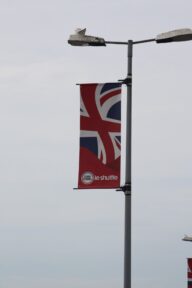
This really was the mammoth journey that it sounds at 936 miles which took a door-to-door total of 17½ hours +1 hour of time change. Fortunately as all the countries involved are members of the EU we were able to cross all borders without stopping (except of course our own UK border which is a shamefully tedious process thanks to our “little Englander” 1‑foot-in 1‑foot-out policy on Europe). The borders are so low-key we missed the sign welcoming us to Holland!
We set off from Sheffield at 6.30am, collected one of our party from South Mimms services on the M25 at 9.00am and arrived at the EuroTunnel just before 11.00am. After a slight delay to the EuroTunnel service we set off from Calais around 1.30pm UK time (2.30pm European time). We then pretty much remained on schedule, crossing the border into Czech Republic at around 11.30pm European time after 2 short stops at Motorway services in The Netherlands and Germany.
Just before crossing the border we were stopped by German police who checked our passports, drivers license and car registration document. They were very helpful and friendly and directed us to where we could buy a tax vignette for the Czech roads. The cheapest vignette cost 310CZK (~£10) for a 10 day pass. We finally arrived at our Hotel in Prague at around 1.30am local time.
All of the roads had remarkably light traffic, if there had been significant delays we would have arrived very late. In future I would recommend doing a shorter journey, or getting one of the Flexiplus tickets for the Eurotunnel. This would have cost us around £200 more (doubling the cost) but if we had bought a flexible ticket we would have arrived at least 1½ hours earlier (or more likely would have set off a bit later).
Prague
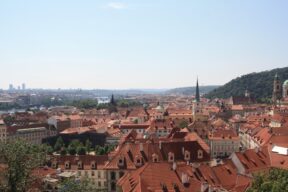
Prague was a very attractive city. We didn’t see quite as much as we would have liked as there was a heat wave with the temperature around 40°C which quite literally sent us scurrying back to the air-con of the car!
We stayed at a place called Pension Karel which cost us around £63 in total for 4 people for 1 night. This included free secure parking and free breakfast at a time to suit us! The owner was very friendly and didn’t mind that we had arrived so late. He also provided a very lovely breakfast in the morning — toast, tea, boiled eggs, ham and a few other things I’ve forgotten. The rooms were clean and comfortable and the shower was good. Our only “complaint” would have been the lack of air conditioning — but I had known this when I had booked. We just hadn’t anticipated such an intense heatwave. The website for the accommodation wasn’t working when I booked, but thanks to Google-cache I was able to get an e‑mail address to contact them directly on info@pension-karel.com (the reply came from avrora@volny.cz so you could try that too). There wasn’t an option to pay with card, only cash, but both the local Koruna and Euros were accepted.
After breakfast we walked about 10 minutes to Lužiny metro station and caught a yellow line (line 2) train to Můstek station. Following the advice of the owner of our accommodation we then changed onto the green line (line 1) and went to Hradčanská which is at the top of the hill where several of the main sites of Prague are found.
We didn’t entirely follow the map I had made but it was a useful guide to the locations of some of the monuments. We strolled across the tram lines, through some beautiful gardens and past St. Vitus Cathedral and then headed down the hill and across the Charles Bridge (Karluv Most) into the old town. We then headed back to Můstek station and onto a Metro back to our accommodation.
I would recommend a visit to Prague — we would have liked longer to see some more of the sites. Everyone was friendly, and whilst there were a lot of tourists it wasn’t as overcrowded as I’d expected. I would also stay at Pension Karel again, although I would probably check the weather forecast first and consider looking for somewhere with air conditioning if it was likely to be so hot again.
Het rijden (2): Prague — Tatabanya

This drive was a mere 4½ hour 300 mile journey via Slovakia. There were no border controls to navigate as all countries were proper EU members and the roads were all decent. We needed another vignette for the roads in Hungary, but I had already bought this in advance from tolltickets.com. The cheapest vignette is a 1‑week vignette which costs 2,975 Ft (~£10). The Hungarian system is fully electronic and uses ANPR so we didn’t even have to display a sticker.
Tatabanya

One of our party has extended family living near Tatabanya and we had been invited to stay with them. As a result we didn’t visit Budapest on this trip (even though I had made a map just in case) but we did enjoy some beautiful scenery and some wonderful food. The temperature was still really hot so we didn’t do much other than relax, eat, and drink. And drink. And drink! It turns out that our hosts had about 20 varieties of grapes and produce their own wine and liquor and we were invited to try several different varieties, all of which were excellent. Fortunately my partner excused herself from any more than a single glass of wine and was able to do the driving the next day!
Het rijden (3): Tatabanya — Thessaloniki
This was our first potentially challenging journey. Things started off ominously when we took a slip road onto a new (and unfinished) stretch of motorway that wasn’t properly coned off and thanks to following the sat-nav (great work TomTom!) we took the exit and had to reverse back when we realised the road wasn’t yet built!
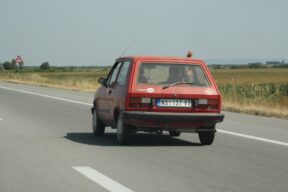
We had 3 borders to cross — Hungary into Serbia, Serbia into Skopje, and from Skopje into Greece. We also knew we needed a green card for both Serbia and Skopje, but our insurance company (along with most other western European insurance companies) declined to provide one for Skopje. They did however provide one for Serbia. The officials at the Serbia border were of the standard humourless type, but they were satisfied with our green card, car registration document and passports and we passed through after about 20 minutes without any issue.
The officials at the Skopje border were inefficient, miserable and officious — they were in fact only beaten in the “most unpleasant border crossing experience” by our very own UK border control who must be Olympic champions at “providing an unnecessarily long and tedious border crossing”. So, after an hour of waiting (in a queue of about 10 cars) we were sent to obtain some 3rd party insurance to cover us whilst we were in the country. We had known about this in advance but had hoped to get lucky and get waved through as some people have been in the past. Sadly it was not to be and we had to part with €50 (at least they took Euros) for the insurance cover, despite planning to cross the country in only 2 hours.
Thankfully our final border crossing (back into civilisation) was a relative joy — taking about 5 minuten, and included being welcomed by a friendly Greek official (although in fairness it probably helped that we greeted him in Greek).
Thessaloniki
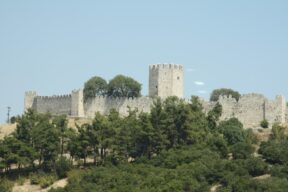
We were staying on the West side of Thessaloniki and the things we might have gone to see were all to the East which would have required a time consuming journey through the city so we elected to set off in the morning to give ourselves more time in Athens before our ferry.
We stayed in a very nice hotel called Hotel Gala which cost a total of €60 for 2 twin rooms. The rooms were clean, the beds were comfortable, the showers were good, the air conditioning worked, and in the morning we were offered some unexpected free coffee by the friendly owner. I was relieved as this was the only accommodation that hadn’t replied to my e‑mail prior to our departure. The hotel was difficult to find with TomTom, so I resorted to turning on roaming data (50Meg for £10 — thanks for the awful value EE) and using Google Maps (please get proper offline maps sorted out Google!) which got us near enough that we could see the bright neon sign at the front of the hotel. I would definitely stay at Hotel Gala again.
Het rijden (4): Thessaloniki — Athens
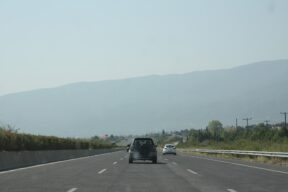
This was one of the easiest drives at only 320 miles in 5 hours. Whilst the Greek motorways aren’t Western European standard they are a lot better than everywhere else we drove though outside of Western Europe. There were annoyingly frequent tolls for small amounts (come on Greece — get a system implemented where we can pay it all in 1 go when we exit the motorway!) which totalled to just under €25. These probably added 30 minutes or so to the journey.
We could have taken a detour to visit Mt Olympus but decided we’d rather have a little time in Athens and not have to rush to get the ferry.
Athens
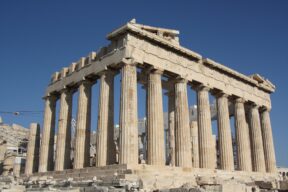
Athens was fantastic. We visited it briefly before getting the ferry from Piraeus to Heraklion, and then we had a much longer visit in the morning when we arrived back on the return ferry.
We didn’t see any evidence of any trouble at all and everyone was as friendly and welcoming as I’ve always found the Greek people to be. I highly recommend taking all the “riots” on the TV news with a truck load of salt and visiting Athens if you have a chance.
The metro service was quick and ran on time (which did surprise me a bit), the only down side was the tinnitus-inducing level of noise. I would advise getting ear plugs if you plan to use the Athens metro!
On our first visit to Athens we arrived in the late afternoon and most sites were closed so we just had a little wander around and then had a beer in a nice bar overlooked by the acropolis.
We were lucky to see Athens in the morning on our second visit. After getting the ferry back from Crete we arrived at 6.30am and used the map I had made and got the green line (line 1) metro directly from Piraeus to Monastiraki. We were in the centre of Athens for 7.30am before any other tourists arrived. We opted to see the Parthenon first so we could get the uphill walk done before the day started to get really hot. We walked through the ancient Agora and arrived at the entrance to the Acropolis site just as it opened. We then managed to out-pace the coach load of American “campers” who had also just arrived and were the first people at the top. As you can see from the picture I’ve included we were able to get photos of all 3 major monuments on the acropolis without anyone else in sight — an almost unique experience! We then walked back down and walked to the temple of Zeus via the Roman Agora. Once we’d seen the temple of Zeus we’d had enough walking, and it was getting hot, so we grabbed a quick drink and then headed back to the metro.
We will definitely go back to Athens, the sooner the better.
Greek Ferries
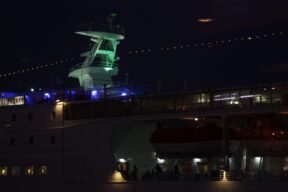
The Ferry to and from Crete was really good. It is possible to travel through the day or the night. We elected for a night crossing with a 4‑bunk cabin, as whilst this was quite a bit more expensive, it meant we didn’t lose a another day to travel. It also meant that myself and my partner, who both suffer from sea sickness, could get to bed in a cabin (which in both our cases prevents us getting sea sick).
We all had some food and a couple of beers before the ferry left which predictably set us back nearly €100 — not great value, but not as bad as similar “captive market” situations in the UK. Both ferries left slightly late and arrived slightly late (~30 mins) but otherwise ran well and as expected.
The only piece of advice I would give is not to book too far in advance. I was regularly checking the price for 6 months before we departed, and then when I eventually came to book 6 weeks before departure the total return price had suddenly dropped from €577 to €400! I also found “inboard” cabins were cheaper than “outboard” cabins, and that the slightly earlier ship was a little cheaper than the later ship (there are 2 ships each night). It was worth booking these cheaper options as in reality we ended up with an outboard cabin and the two ships departed and arrived only 10–15 minutes apart.
Crete

Crete was lovely as always. We had great company, great food and a nice relaxing time. Prices since last year have fallen dramatically (which is fortunate given how much wages have been cut there). A 500ml bottle of Mythos was down from ~€2 last year to €0.95 this year. Alpha beer was down to €0.85 for a 500ml bottle. Our main supermarket shopping trip was only ~€50 (I’d anticipated €80 based on previous experience).
We took a trip to Vai beach on the North-East of the island and also went to the Aquarium near Heraklion. We had planned to visit the WaterCity water park but they have stopped doing the “half day” price they used to offer, so it is now a full €25 full day or nothing. A full day is too long really and €25 for ~3 hours is just far too expensive. Personally I think this is a really short-sighted move, especially given the tough economic climate in Greece at the moment. Three of us also found and explored the[intlink id=“661” type=“post”]Sarakina Gorge[/intlink] which I have written about in another article.
There are loads more things to do on Crete, but we had done most before and just wanted to have a few days of “down time”. If you want to know more about things to do in Crete take a look at the Google map I made a few years ago.
It goes without saying we’ll be going back to Crete again next year.
Het rijden (5): Athens — Ioannina
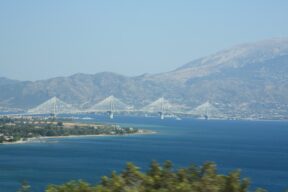
This was another easy drive at only 260 miles in 5 hours. There were no borders to cross but there were a few tolls and the special toll paid to cross the 1.8mile long Rio-Antirrio sea bridge which is a magnificent construction across the entrance to the gulf of Corinth. In total we paid about €25 in tolls, of which €13.20 was for the bridge. The South side of the gulf of Corinth was especially attractive and we had the opportunity to visit ancient Corinth. We decided not to visit on this occasion as we wanted as much time in Athens as possible and hadn’t set off until 2pm. The rest of the journey was easy. As we got further North the land got greener and more mountainous, but other than that North-West Greece was like the rest of the country — rugged and sometimes scruffy, but always easy on the eye.
Ioannina
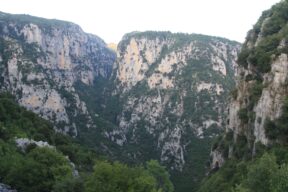
We actually stayed 15 miles North of Ioannina in a village called Ano Pedina. This was only a few minutes in the car from the little-known Vikos Gorge which we visited. This gorge holds the Guinness World Record for “Deepest Gorge” in the world as other, deeper gorges are much wider. The Vikos Gorge is almost as deep as it is wide and was consequently pretty spectacular. We viewed the Gorge from the Western side just past the village of Monodendri as this was a quick journey and we arrived not long before sunset. If we visit again I plan to try viewing from the Eastern side near Vradeto. We didn’t do any hikes into the gorge or see any of the famous hump-backed bridges, but I would definitely visit them in future as the wildlife at the bottom of the gorge is apparently spectacular.
We stayed in wonderful accommodation called Hotel Ameliko. There were 2 men running the business who were very friendly and helpful. We were invited to join them for an evening meal which we gladly accepted. They don’t offer a menu but said what they were planning to make — roasted vegetables and Greek salad for a starter, and giouvetsi for a main course. I actually have a giouvetsi recipe myself so knew how good it can be and was delighted when they mentioned it. One of our party is a vegetarian but our hosts said this was no problem, they’d make him something special — this turned out to be stuffed peppers which he really enjoyed. Almost all the food came from the hotel garden and the food was in the top 5 most delicious meals I’ve ever eaten. The bill was an almost comical €8! We did also drink plenty of beer and wine however, for which the bill was a slightly expensive €57. Overall though €65 for food and drink combined was excellent value.
The room itself was clean, the beds comfortable and the shower excellent. There was also free parking on the street, which in such a small rural village in Greece required no security. We paid a total of €98 and will definitely visit again.
Het rijden (6): Ioannina — Dubrovnik
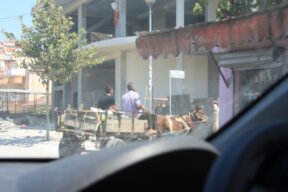
This was the journey I had been most concerned about. When I was planning the trip I really wanted to see the Adriatic coast, and Croatia in particular, but couldn’t find any way to avoid driving through Albania. I have nothing against Albania itself (in fact I understand it is quite an up-and-coming tourist destination) but I had heard first hand stories (and read even more accounts online) of the dangers of Albanian roads and Albanian drivers! After some deliberation I decided that I had managed to survived the Cretan roads in the 1990’s and seen the roads of Rome and Boston, which sounded comparatively bad and thought that we should go for it. It did mean that I felt obliged to volunteer to drive the entirety of this leg of the journey — 360 miles in 8½ hours!
The first hurdle was that we required a green card for Albania, which our insurance company didn’t provide. This meant we would probably need 3rd party cover bought at the border for €27. I had read many cases online of people just being waved through the border without an insurance check so we hoped we might get lucky. The border was reasonably quick and we were waved through without requiring insurance — a positive start!
The roads were immediately somewhat worse than the Greek roads we had left, but they were still a good width and smoothly tarmaced so we were able to make decent progress. However after about an hour the surface of the road suddenly ended and we found ourselves driving on a 4 lane gravel track, along with other (very slow) tourists, local (very fast) Albanians, and a large number of huge lorries. This lasted about 30 miles, which takes a long time at 20 miles per hour! After this excitement the roads remained surfaced for the rest of the journey with most being new and good quality. The only remaining exciting parts of the journey were the lack of bypasses for urban areas, meaning we had to drive through several towns. We deliberately took the most Western route which avoided Tirana and instead passed by Durrës. We saw quite a few very dangerous over-takes and at least 1 horse-drawn cart, confirming our stereotypes of Albanian roads. Hopefully the construction of all the new roads currently underway will be finished in the next 3–4 years and things will improve considerably as they have done elsewhere (e.g. Crete)
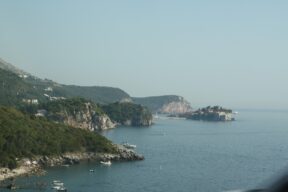
Following Albania we crossed into Montenegro on the Shkodra — Bar road. The border was reasonably quick (around 10 minuten) and this time we had the required green card and were able to pass without significant delay. The roads in Montenegro were initially the second worst roads we encountered (beaten only by the Albanian gravel) — similar to a narrow country lane in the UK. When a lorry came the other way we had to slow almost to a stop and bump off the tarmac onto the gravel at the side of the road so it could get past. The roads improved after a few miles and remained acceptable for the rest of the drive through Montenegro. The speed of the drivers also decreased back to safe levels and the number of “exciting” over-takes was almost negligible compared to Albania.
The coastline of Montenegro was especially beautiful, but sadly over-populated with tourists. Some of the best looking beaches were so covered by sun loungers and umbrellas that we couldn’t see any of the sand. I would consider a stay in Montenegro if we could find somewhere without so many tourists, but with such a short coastline I think it may already be too late.
Finally, we crossed the border into Croatia near the coast and got through without problem. This border took around 30 minutes which was a little irritating as we didn’t want to miss the sunset on the coast. We could understand the importance of the check however as this is now an EU border. In the event we managed to see 3 sunsets and get lots of photos.
Dubrovnik
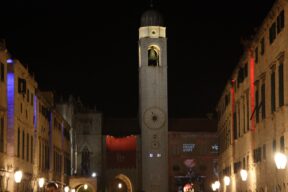
Dubrovnik was stunning. It is the place all 4 of us most want to go back to. Things didn’t start off all that well — finding our hotel and somewhere to park took nearly an hour of driving round 1 way systems during which time I swore quite a lot. Eventually we managed to get the car into the car park and found our way to the Kusalo Guesthouse. The Guesthouse was nice enough, with reasonable beds, functional air conditioning and a reasonable shower, but although I can’t find anything particularly bad to say I think next time I visit Dubrovnik I would look for somewhere else to stay. The fairest way to put it was that there was nothing particularly wrong, but compared to the other places we had stayed on the holiday it just wasn’t as nice. The shower in the morning was also cold which didn’t go down well with a couple of our party.
Following the map I’d made we walked from the guest-house south-west towards the old town. Before exploring the old town itself we looked for somewhere to eat. Initially we decided to try a restaurant on the right-hand side of the little square, but after waiting for 15 minutes for any service we left and decided to try the pizzeria at the opposite side of the square. Service here was much better and the food was also good.
After eating we walked into the old town which was stunning. My partner immediately swiped my camera and started snapping away. We made our way slowly through the old town and eventually I steered us towards a bar I wanted to visit called Buza I. This is a bar which is accessed through a passageway cut into the city wall and overlooks the sea. It was stunning and well worth finding but it was also a place best to have only 1 drink as our 4 cocktails cost nearly €30.
After our drinks we headed back to the guesthouse to get some much needed sleep. We didn’t have time to walk the city walls or see the Lovrjenac, we didn’t visit any other parts of the city (e.g. the harbour) and we didn’t even fully explore the old town. These are all things we want to go back and do.
Het rijden (7): Dubrovnik — Venice
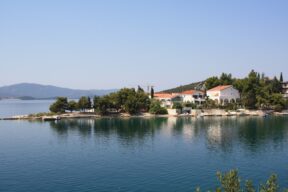
This was the most scenic drive that we did. There is a new road that goes all the way up through Croatia, but we wanted to see the coastline so we took the older slower road along the coast. This did add about 2 hours to the journey but was worth it for the 485 miles of views over 10 hours. We had to pass briefly through Bosnia and Herzegovina as Croatia is split in half. These border crossings were fairly swift and straight-forward and there was no issue about our lack of greencard. The drive through Bosnia is only 5½ miles, which takes less than 10 minuten.
We would have liked to visit the beaches on the island of Rab, but there wasn’t enough time. We did drive past in the hope that there may also be a nice beach on the mainland near the island, but sadly this was not to be. On a future trip I would definitely want to find time to try the beaches on the island.
Venice

Venice was our first real disappointment of the holiday. It was basically a huge tourist trap, nothing felt very real. There was some stunning architecture and perhaps if the sun had come out sooner or we had been less tired we might have enjoyed it more, but we all felt that it was an over-hyped rip-off. Now I can say I’ve “been there and done it” I don’t think I’m very likely to visit again, at least not when there are so many tourists (i.e. in August). The only positive thing I can say is that it didn’t smell like we were warned it often does in summer.
We again followed a map I’d made and after spending about 30 minutes figuring out how to get tickets, and where to catch it (get some proper multi-language signs put up please Venetians!) we took the #1 vaporetto (water bus) for €7 each to St. Mark’s square. From there we walked back, via the Rialto bridge. On the way back we stopped for food at a restaurant which was distinctly average and very expensive (4 large cokes, 2 pizzas and 2 pastas came to nearly €80)
We stayed on the outskirts of Maestre on the mainland at a place called Hotel Villa Dori. The hotel was OK, although the bunk beds provided weren’t particularly comfortable and everything the hotel offered cost extra (a map of Venice was €2!) If I ever did return to Venice I would look for somewhere else to stay.
The hotel was in an area which didn’t look particularly friendly at night (although it looks nice on Google earth!). We were recommended a restaurant in the area which we were rather dubious about, but it was actually a very good meal. I don’t know the name of the restaurant, but it was on Via Venizia near the junction with Via Veneto. I would eat there again.
One final thing to note about Venice is that every bill we received contained a “tourist tax” of around €2-€3 per person. We found it hard to believe and very objectionable that an economy so dependent upon tourists so overtly rips them off for a little bit extra each time they pay for anything. Between the 4 of us we ended up paying over €30 extra whilst in Venice as a result of this tax. We wouldn’t have found the price so objectionable but for the fact that everything in Venice is already a huge rip off — it was by far and away the most expensive place we visited.
Het rijden (8): Venice — Munich

We drove from Venice to Munich directly over the Alps. It had been the plan to take the Grossglockner High Alpine Road, but sadly the sat-nav took us a slightly incorrect route and by the time we realised it would have added an hour to our journey to correct the route. We did however see some stunning scenery, and having missed the Grossglockner we now have an excuse to repeat the journey. The journey itself was about 350 miles and took around 6 hours. We used far less fuel than we had expected — hardly any more for the distance than we used on most of the motorways. I guess all the downhill engine braking saved a lot and made up for the fuel used going up.
There were tolls on the Italian roads, which was especially annoying as we spent most of our time on the toll road stuck in stop-start traffic and lost over an hour. We couldn’t see any reason for the delays (i.e. there were no accidents we could see). I would recommend avoiding Italian roads if possible — the drivers are often dangerous, the prices are a rip-off and progress (in my experience) is usually pretty slow — a disappointing combination.
A vignette is required for Austrian roads. It costs about €9 and can be bought in advance from tolltickets.com. Some of the Alpine roads are private or have tunnels with tolls. If you take the motorway there are no additional tolls but the views are far less spectacular.
The Austrian Alps
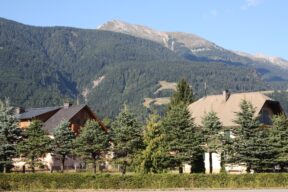
Austria and the Alps were beautiful and are one of the places we most want to go back to. The scenery is stunning, the architecture very attractive, and the overall experience really peaceful and pleasant. The roads are well maintained and no problem to drive in a modern car as long as you are prepared to use first gear regularly for each hairpin bend. We hope to go back and drive the Grossglockner, visit Hallstatt and hopefully see at least 1 glacier. I’d also like to sample some Austrian food as we didn’t stop on our journey to eat. The Austrian Alps were the most peaceful and relaxing place we passed through — they looked to be an ideal location for a week or 2 of gentle walks, eating, reading and relaxing. I believe it is possible to get quite cheap deals in summer as most of the Alpine tourist industry is geared up for winter sports so there is lots of empty capacity in summer.
Munich
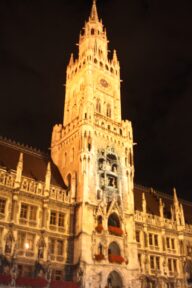
Munich was brilliant — the friendliest most welcoming place we visited on the entire holiday. Everything was stereotypically German — it all worked as it should! We stayed at Guesthouse Siddiqi Pension which was only 5 minutes drive from the overground rail station Karlsfeld. Trains from here run regularly all night to and from Munich city centre and take only 18 minutes. 24 hour parking at the rail station was just €1 and when we nearly missed our train the driver saw us out of his window and instead of setting off like a bus or train in UK would have done, he waited and reopened the doors so that we could board.
The guesthouse was clean and comfortable. There were only shared bathrooms available (which I had known when I booked) but we didn’t have to wait long in the morning to get into the bathroom, and the showers were good and hot. We paid €98 in total for our own room with 4 bunks.
We were quite late getting to Munich and didn’t arrive in the city centre until around 11pm. The first thing we were greeted with after exiting the station was a group of mildly-drunken German young people surrounding a busker and singing Yellow Submarine loudly which was an amusing and uplifting arrival. We used another of my maps and headed for the Hofbräuhaus hoping to get a beer there but it was closing by the time we arrived so we quickly made our way to another pub nearby. The waitress there told us we could only have 1 drink if we were quick as they had to close in 20 minutes. We agreed and had some excellent German lager. We were immediately greeted by the group of Germans (we presumed locals) sat at the table next to us. They spoke very good English (of course) and welcomed us to Munich, telling us we had been very lucky to get a drink so late! After our drink we headed back to the train, stopping off at a delicious kebab shop which also sold bottled beers and champagne! We got some kebabs and a bottle of beer and consumed them on the walk back to the central station.
We will definitely go back to Munich, and stay longer. We are very keen to have a proper night out there as well as visit some of the sites (e.g. the BMW museum, Munich Zoo, the Olympic park, etc)
Het rijden (9): Munich — Sheffield
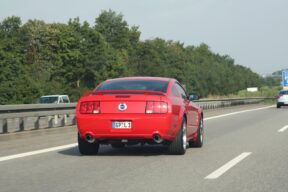
This was our second longest drive of the holiday. We followed the route chosen by the sat nav which took us in an almost direct line back through Germany and France to Calais. This was a mistake, as we spent around 2⁄3 of the journey in France. I personally felt really irritable with the French road network after our experiences elsewhere in Europe, so much so that I think we should charge French drivers to use the roads in the UK. France basically sits between the UK (free roads), Holland (free roads) and Germany (free roads) in Western Europe. The French roads are not free; they are in fact a considerable rip-off. We paid around €60 for our 5 hours on the French roads — more than anywhere else on our trip — and more than we pay for the tax on the car in the UK (£30) for a whole year. This annoyance was compounded as we had got used to the quality (and speeds) of the German Autobahn and were then confronted with lower quality, slower roads, peppered with hidden cameras. To rub salt in the wound the French have banned all camera alert systems so there weren’t even any good databases of cameras to help us avoid them. In future I will go to considerable lengths to use the German roads and avoid the French ones — shame on you France.
That said, we didn’t hit any significant traffic and completed the 595 miles to Calais in around 8 hours. We then had to endure 3 hours of queues, delays and border control before our EuroTunnel train eventually departed at 7pm. This was by far and away the biggest delay of any kind on the entire journey and it can be credited to just what Britain and France can achieve when they work together — well done chaps. Next time we build a tunnel to the continent I suggest we tunnel right under France and go direct to Germany as this will cut travel times by at least 2 hours (and even more if we just let the Germans run the entire operation).
In all we drove 845 miles home from Munich and arrived home 17 hours later at 11.00pm UK time. We would have been a little quicker but we had to stop on the M20 on the way home to top up the coolant level in the car. We know the radiator was the source of the leak as it had to be replaced (for £220!) but we don’t know what damaged it. I’d guess it was either the Albanian gravel road or that a combination of 40C heat, Alpine driving, 120mph on the autobahn, constant air conditioning, and 5000miles in 16 days just gave the car a workout it wouldn’t normally experience!


“Hi Jon, fanstastic resource thanks for producing this. I'm struggling with trying to get a R8074 to run into a…”